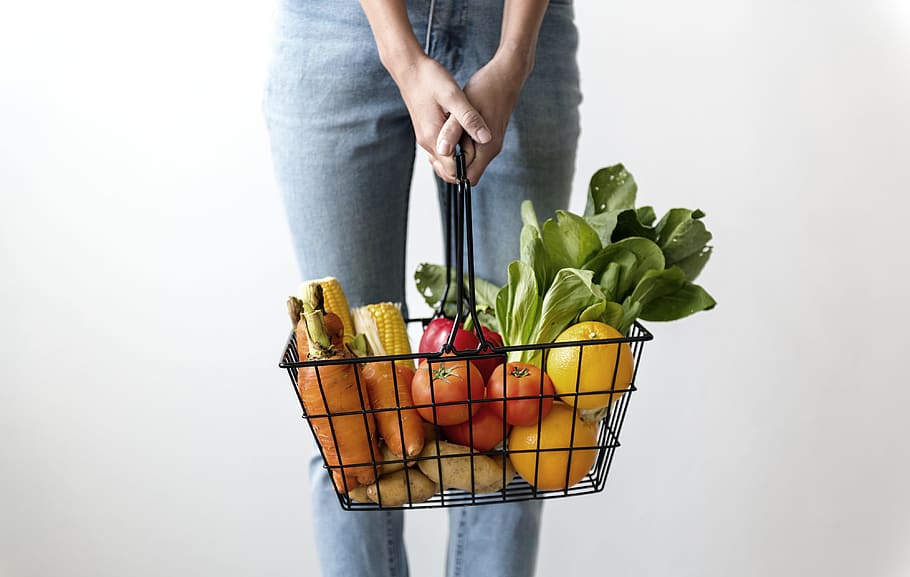By Crystal Gwizdala
Cost of healthful food is the most cited reason people don’t buy more fruits and vegetables, according to Food Insight.org.
Because why buy fruit when a sausage, egg, and cheese biscuit with a 24-ounce coffee from Speedway costs $2.99?
Wait – let’s check our options. Three pounds of Fuji apples from Meijer costs $1.99, averaging 25 cents per apple. I could buy 12 apples for the same price as the Speedway breakfast.
Now if we’re just talking calories, I can eat six apples for one of those biscuits. As someone who likes to eat, I can tell you one breakfast biscuit wouldn’t satisfy me. Six apples though? Yeah, I’d have leftovers.

We’re spending almost as much money eating out as we spend on groceries.
So we like eating out—what’s the big deal?
For the first time ever, Americans spent more money eating at restaurants than buying groceries in January 2015, according to economist Mark J. Perry.
Yes, eating out is seductive. But imagine the potential for saving money—you could invest in your health with quality foods and still save.
Rather than eliminate eating out, we can limit spending by setting a monthly budget.
Talia Koren, food and cooking blogger, reported saving $261.14 in a month by reducing restaurant expenses—even with spending more on groceries.
For most of us, income doesn’t affect how healthy we eat.
The U.S. Department of Agriculture (USDA) found that Americans, regardless of income, eat equally poor diets.
The average American spends about $6.21 on food daily. According to the USDA’s Healthy Eating Index, the amount of money spent on food does not affect how well—or how poorly—a person eats.
Low-income families, however, may still struggle to meet dietary recommendations—even with food stamps, also known as SNAP.
According to The Conversation.com, a family of four would need to spend $600 beyond their SNAP benefits to reach MyPlate dietary recommendations. Access to grocery stores with healthy options and cheap prices challenges low-income neighborhoods, too.
How can we make thrifty, healthier choices?
The USDA recommends re-allocating our food budgets. Most Americans spend too much of their budget on protein foods, especially meats.
Instead, we should focus on fruits and vegetables. Of our food budget, a quarter is spent on fruits and veggies when we should be spending nearly half.
I can hear the naysayer: “You’re telling me not to buy meat? How do you get your protein?”
Plant-based proteins are markedly cheaper than meats—think beans, legumes, or hearty grains like quinoa. They pack a punch, too.
Check out these comparisons:
| BLACK BEANS | GROUND BEEF | RED LENTILS | CHICKEN BREAST |
|---|---|---|---|
| 22.5g 1.5 cup serving | 22g 3 oz. serving | 30g 1.5 cup serving | 26g 3 oz. serving |
| $0.44 ($0.59/15.5 oz. can, Meijer) | $0.85 ($4.49/1 lb. lean beef, Meijer) | $0.20 ($3.49/ 4lb bag, International Foods & Spices) | $0.56 ($2.99/1 lb. chicken breast, Meijer) |
So plant-proteins are half the cost and you can eat twice as much food? And you get tons of fiber? And they have zero cholesterol? We have a clear winner.
Okay, what should we eat?
How about an example recipe for a nutritious, thrifty meal?
Lentil chili, six hefty 4-cup servings
| Ingredient | Price for amount1 | Bulk cost | Store purchased |
|---|---|---|---|
| Kidney beans, 1 can | $0.59 | $0.59 / 15.5 oz. can | Meijer |
| Celery, 1.5 cup | $1.202 | $1.79 / bunch | Meijer |
| Carrots, 2 whole | $0.262 | $2.49 / 3 lb. bag | Meijer |
| Onions, 3 whole | $0.992 | $1.99 / 3 lb. bag | Meijer |
| Red lentils, 2 cups | $0.772 | $3.49 / 4 lb. bag | International Foods & Spices |
| Bell peppers, 2 whole | $2.50 | $1.25 / each | Meijer |
| Diced tomatoes, 28 oz. can | $0.89 | $0.89 / 28 oz. can | Meijer |
| Spinach, 4 cups | $0.712 | $1.99 / 10 oz. bag | Meijer |
| Low-sodium veggie brother, 6 cups | $4.19 | $2.79 / 32 oz. jug | Meijer |
| TOTAL COST | $12.10 | Divided into 6 meals = | $2.02 per meal |
Try telling me you spend only $2 at McDonald’s.
Granted, these items aren’t always on sale and not everyone is near a specialty food store. If you’re vigilant about checking ads for sales and penny-pinching though, finding bargains is doable.
No fresh produce on sale? Can’t eat a bag of spinach before it wilts? Buy frozen. Plain, frozen vegetables typically cost $1 to $2 at a grocery store.
So, let’s look at the big picture.
In 2015-2016, the Center for Disease Control and Prevention reported the prevalence of obesity in adults to be 39.5 percent and 18.5 percent in youth—that’s about one in five kids and two in five adults. Yikes.
According to Health Affairs.org, $147 billion was spent on obesity-related conditions like heart disease, hypertension, and diabetes in 2008. Those numbers are projected to reach $580 billion in 2030.
Even one junk food meal can cost us. According to The Washington Post, foods high in refined carbohydrates and sugar can narrow arteries and spike insulin response, lowering blood sugar.
Sure, that pizza will give you a moment of bliss. But afterwards, there’s a good chance you’ll feel sluggish, irritable, and anxious.
Healthy eating is not expensive. Eating unhealthy is.

